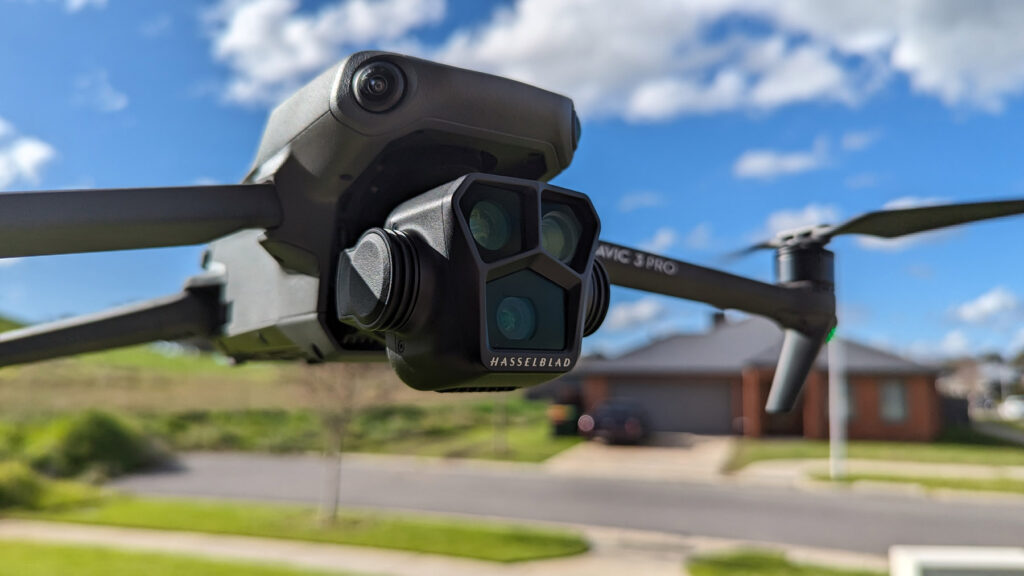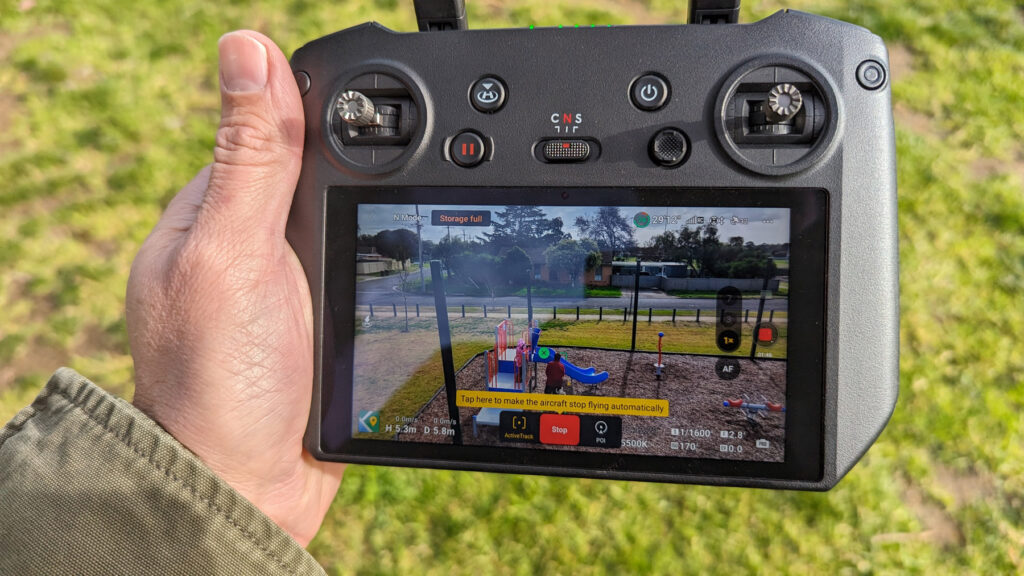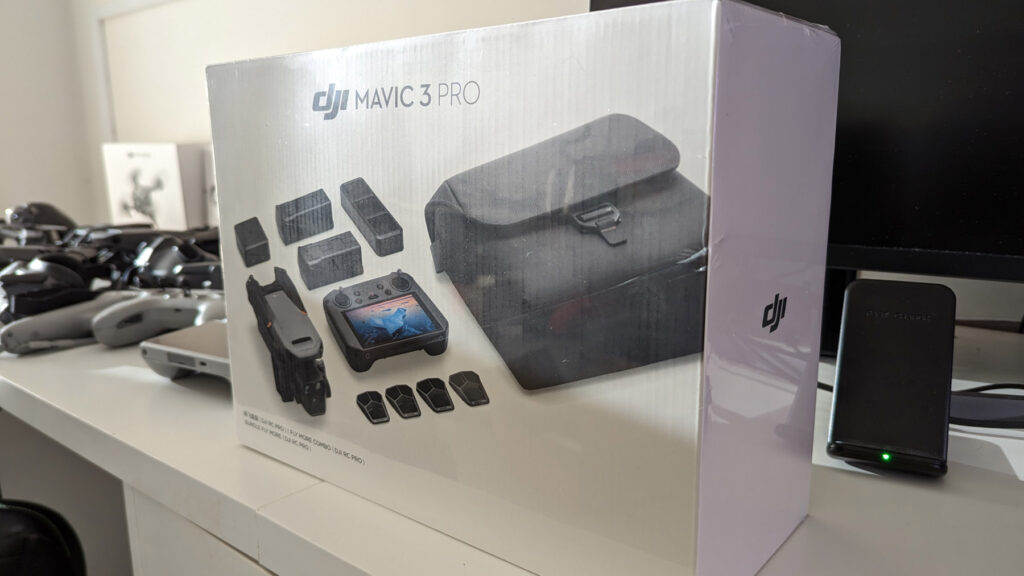DJI’s Mavic 3 Pro is the flagship drone in their consumer/prosumer range. This marks the third drone in the Mavic 3 range, the Classic, Standard and now the Pro. Each of these offers different features, particularly the camera system, while the main chassis remains the same between models.
The most capable, most expensive Pro edition delivers a triple-camera system, allowing you to capture the world better than ever before, thanks to great quality, zoom capabilities and all the technology smarts you’d expect like collision avoidance and a range of flight modes.
I’m seriously impressed with the engineers at DJI and their continued efforts to stay ahead of the competition, packing more into the same form factor. In the drone world, there are other manufacturers, but DJI is relentless about iterating each year to drive the industry forward despite what the competition is doing and these efforts ultimately reward us, the customer with a great product.
The folding legs and great carry case, make this drone really portable and when things are easy to transport, you’re far more likely to do it more often. This means you’re likely to have the drone with you more often and when you use it more often, it’s going to deliver better value for money.
If you are a professional videographer or photographer, then the DJI Mavic 3 Pro would make an exceptional addition to your equipment and the shots you can capture (i.e. wedding shots) could help you quickly pay for the investment, then start making a profit from the content you create.
After spending a few weeks with the Mavic 3 Pro, it’s time for the full review.

Camera System
The camera system on offer here is nothing short of amazing, like blow your socks off impressive. I’ve flown drones with Zoom capability before, but nothing like the abilities of the triple-camera system on the Mavic 3 Pro.
Let’s start with the camera in the top left, a 1/2″ CMOS Tele Camera that offers 7x optical zoom, comparable to a 166mm lens. This is capable of capturing at f3.4 and 12MP resolution and in video, 4K/60fps.
The top-right camera is a 1/1.3″ CMOS Medium Tele Camera that offers 3x Optical for a 70mm lens equivalent at f/2.8. This captures in an impressive 48MP resolution while offering 4k/60fps.
The final lens of the triple camera system is the 4/3 Hasselblad camera which is equivalent to using a 24mm lens at f/2.8 – f/11. For still photography, it’s capable of capturing 20MP stills, or 5.1k/50fps videos. For those after buttery smooth videos, you can drop the quality to 4K and capture at 120fps.
You can see that DJI’s first tri-camera system offers multiple focal lengths, building on the strengths of the Mavic 3 range, but taking it to the next level.
When piloting the Mavic 3 Pro, the ability to use optical zoom to get a tighter shot on a subject, while not losing quality is amazing. This can help you adhere to the CASA regulations of not flying over houses or people etc, while capturing the shot you want and would otherwise (with other drones) need to position the drone closer.
As good as the optical zoom is, there is a point where you tip over to hybrid zoom, a combination of optical and digital and at the most extreme 28x zoom, the footage is still impressive and usable, but is a noticeable step down from the otherwise stunning footage from the Mavic 3 Pro. Zooming at this extreme level, allows you to capture items kilometres away.
One potential use case for this is not to simply zoom and capture from where you are, but rather explore things in the distance, then fly the drone closer to a point where optical zoom levels would allow maximum quality of capture.
Something fun to do with this zoom is leverage manual focus, and with a subject in the foreground, gives you that lovely blur of the background, drawing the audience’s attention to the subject. Having this focal length locked in, allows you then to circle around the object, creating a stunning, almost movie-like shot. There’s a new sporting field in development nearby and the empty construction site on a weekend provided a great opportunity to test this out.
There are many use cases for this, such as motorsport events, where you want to keep the drone away from the cars and spectators, but want to get a nice tight, high-quality shot of the action. There are also times when you’ll want to capture wildlife and getting closer to animals with the noise of a drone would disturb them and ruin the shot.


Performance
The Mavic 3 Pro is also a very capable flyer with a top speed of 72km/hr in sport mode, it can certainly move. Most of the time I found myself in Normal or Cine Modes to get those super smooth, easy-to-watch visuals.
The drone offers as much as 43 minutes of flight time, which is more than enough to capture most shots, although you can always consider the Combo pack that includes a charger and 2 additional batteries.
One of the most impressive features of the drone is its flight capabilities. Unfortunately due to CASA regulations, I couldn’t test these to the limit and it’s been clear to me for a while, they’ve failed to keep pace with the technology. One of those regulations is to keep sight of the aircraft at all times.
This drone, like a number of others from DJI has technology that allows it to detect fixed-wing aircraft in the area and return home and land. The drone is capable of flying multiple kilometres from the controller and does a great job of transmitting quality visuals back to the controller. You still shouldn’t fly over homes, people etc, but in a country area where there are empty fields as far as the eye can see, there’s no danger in allowing the drone to fly further than you can see when you have the level of technology and sensors, that the Mavic 3 Pro features.
While the drone is incredibly capable, it’s also one of the easiest drones to fly as well, making it really approachable for end users.
The Mavic 3 Pro comes with a DJI RC Pro controller. This features a similar design to the brilliant RC controller but stands out as something different thanks to its black colour, rather than the typical matte grey.
The controls are much the same and familiar to existing DJI pilots, what is very different is the top, where you’ll find two fold-out antennas which increase the communication range to the drone.
The large touchscreen really lets you appreciate the full visual quality of the camera system and easily make adjustments to the flight mode, zoom levels, select objects to track and more. The controller also allows you to monitor battery levels, with a count down of the time remaining, along with details of the drone height and distance in the lower left corner.
For those who want to take control over the photos, you can fine-tune settings like exposure, ISO, F stop and shutter speed. If you’re planning on using the drone for real estate photography, particularly taking photos at different light levels (sunset with lights on is a favourite), then this is the control you need to achieve the perfect shot.
Sample footage
Below is an example of the stunning footage you can capture with the DJI Mavic 3 Pro, enjoy the 10 minute video, an aggregate of clips from my time using the drone.


Features
The DJI Mavic 3 Pro comes packed with advanced features that augment the flying and shooting experience.
When you spend serious money on a sophisiticated drone like this, you get access to DJI’s obstacle-sensing and avoidance capabilities. This means as you fly, the technology prevents you from doing dumb things. Imagine you are flying and a tree is in the flight path, the drone acts with self-preservation and ignores your inputs to protect itself and your investment. The exception to this is Sport mode, where these sensors are disabled to unlock the max performance, but you are on your own when it comes to safety.
With 2 cameras at the front, another two at the rear and another set of sensors at the bottom, the drone senses virtually all directions. This enables you to have confidence that when you’re using flight modes, you’re pretty safe. While I wouldn’t trust any system with absolute confidence, I was seriously impressed with what I experienced here.
APAS 5.0
DJI’s Advanced Pilot Assistance Systems (APAS) is now in it’s 5th iteration and the Mavic 3 Pro has APAS 5.0, the latest version of DJI’s identification and tracking software. This system enables DJI’s drones to autonomously avoid obstacles in their flight path. Eight wide-angle vision sensors work seamlessly with a high-performance vision computing engine to precisely sense obstacles in all directions and plan a safe flight route to avoid them.
DJI O3+
Being the flagship drone, DJI incldues its very latest transmission technology which offers an insane 15 km transmission range. What I experienced during the review was great quality in transmission, but this is still line of sight, so if you get creative and go for a big panning shot that sees the drop wrap around the base of a hill, there is still a chance you see signal breakup.
Unless DJI wants to put a 5G chip in the drone and the controller and allow both to communicate that way, this will continue to be a limitation.
The signal transmission is helped by the external, foldable antennas on top of the RC Pro controller and this allows a smooth 1080p/60fps HD live feed. Having a low latency and high-quality signal is critical when making sporty moves with the Mavic 3 Pro.
Smart shots
Included with most modern DJI drones are a series of capture modes that help you, capture some stunning shots with almost no effort. This works great if you’re on your own and you won’t always have a friend with you to fly the drone if you want to capture yourself in an environment. Even for those times you do, they may not have the pilot experience to capture it in the way you want.
The DJI Mavic 3 Pro offers the same great Mastershots, Quickshots and Hyperlapse modes we’re used to and now expect.
When I fly drones I do try to challenge myself to fly manually and expand my skills as a pilot, when you do capture that stunning video, you know internally that you were responsible for the inputs that created it, which can be incredibly rewarding.
Panoramas
There are lots of great reasons to create panoramas, but I have a couple of special ones. With 2x 49″ Ultrawide monitors, it’s become quite the hobby to make my own panoramic images for 5120×1440 wallpapers.
The process typically is to flip into camera mode, then select Panorama from the on-screen menu and decide between a full 360 and 180-degree pano. Once you hit the go button, the drone does all the hard work of rotating the drone and camera to capture each segment of the panorama.
Traditionally you’d be left with a bunch of photos written out to your SD card and then you’d have to do the work in an app like Photoshop to stitch them together. With significant onboard performance, the Mavic 3 Pro is able to stitch the photos on-device, which allows you to rapidly create panoramas. If you do this as part of your work, this drone will dramatically accelerate the workflow, assuming you don’t need to edit in post.
If you do need to edit content captured by the drone, DJI recommends a 3rd party app called LighjtCut. While I had an issue with the app on my Android device (Pixel 7 Pro), normally you’d connect the Mavic 3 Pro wirelessly to the LightCut app for quick previewing of clips and AI-based One-Tap Edit without downloading the footage, saving storage on your phone.
There are pre-built templates, powered by AI that will take content like MasterShots and effortlessly create amazing aerial videos, great for sharing on social channels.


Issues
Make no mistake, this is one hell of an impressive drone. If I had to pick on something to pick on for an improvement, I’d definitely point to the touch control over zoom levels, this needs a little work. Most will use the right scroll wheel to control zoom levels, but touching and sliding the zoom level up and down onscreen is slow and jumpier than I’d like. It’s not easy to pinch and zoom like we do on our phones, but I think this would be a better gesture than the tap and slide.
The zoom level jumps as it moves through the lens switch and it feels like the software could be updated to make this silky smooth.
My only other complaint is that there isn’t the same vertical shooting mode offered by the Mini 3 Pro, something I imagined would become standard across DJI drones. There’s certainly enough resolution to crop the sides for a 9:16 vertical aspect ratio, but this does take post-production to achieve in something like Adobe Rush.


Price & Availability
The DJI Mavic 3 Pro is a premium product, and its price reflects this. It’s certainly not the cheapest option on the market, but considering the high-end features, superior performance, and unmatched camera system, it presents significant value for enthusiasts and professionals alike.
The Mavic 3 Pro is available now from DJI.com and starts at A$3,099. This level comes with the standard RC controller, rather than the Pro controller mentioned above.
The Mavic 3 Pro Fly More Combo (DJI RC) is priced at A$4,199 and includes two additional batteries, a charging hub and ND filter set. Again this comes with the great RC controller, but not the RC Pro.
The Mavic 3 Pro Fly More Combo (DJI RC Pro) is the model reviewed and is priced at $5,329. This comes with the new and improved DJI RC Pro controller with 1080p screen, the additional 2 batteries, a charging hub and ND filters.
The absolute flagship of the model lineup is the DJI Mavic 3 Pro Cine Premium Combo (DJI RC Pro). This model includes everything above, as well as a 1TB SSD and supports the Apple ProRes profile.
Something to consider are the accessories which range from a wide-angle lens option for A$229, a Prop guard for A$59, a car charger for A$79 and even the DJI Goggles 2 Motion combo for A$1,299 which is compatible with both the Avata and the Mavic 3 Pro, giving you a first-person view from the drone’s amazing camera system.
















Overall
The DJI Mavic 3 Pro is a giant leap forward in the realm of consumer drones. With all the best technology from DJI, this really is a powerhouse capable of producing stunning footage, great battery life and a big price tag to match.
For those who are serious about aerial photography and videography, the Mavic 3 Pro is, without a doubt, one of the best drones money can buy. For those who deploy this for commercial purposes, it’s likely the content you create with it, will pay for the drone in no time. This could include videos for online content, real estate clips, tourism ads, TV commercials and much, much more. While DJI has a dedicated commercial line of drones like the Inspire, it wouldn’t surprise me to learn the Mavic 3 Pro gets a bit of use on film sets as well.
This high-flying Mavic 3 Pro sets a new benchmark for the competition to aim for and reminds us once again why DJI remains the king of the skies.
